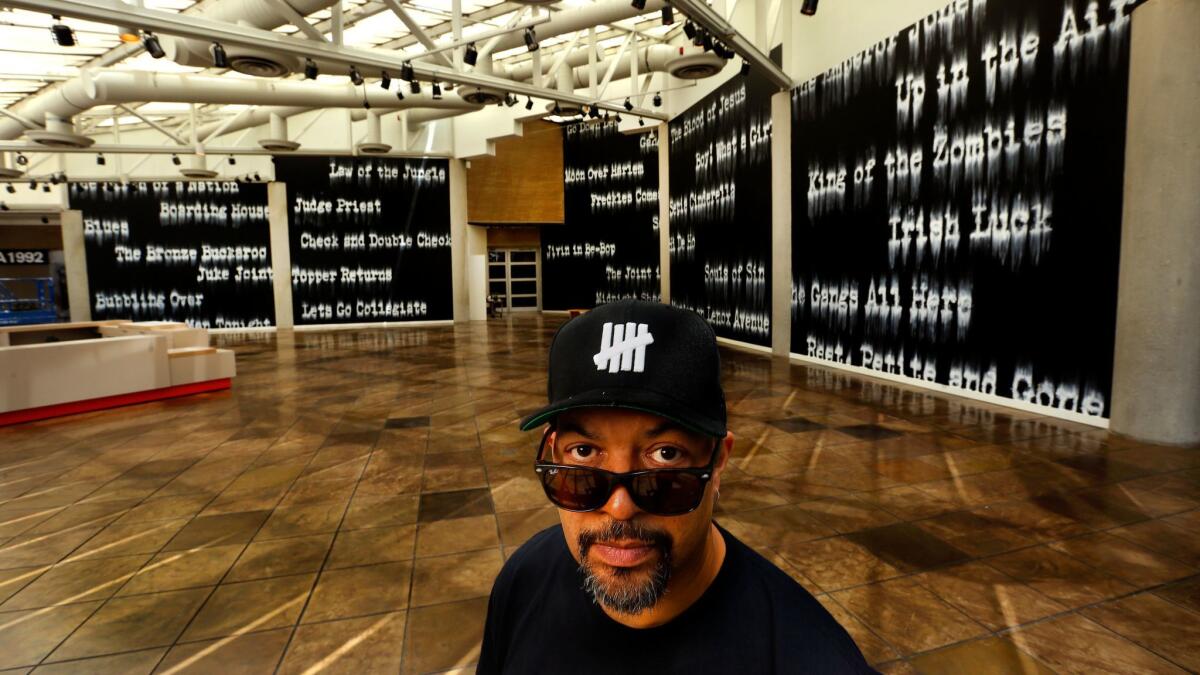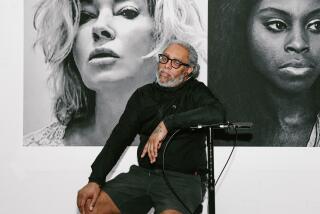His art centers on African American actors whose film titles ‘Fade to Black’

The California African American Museum is teeming with ghosts. They haunt its lobby atrium, which is airy and still, bleached out from sunlight seeping in through a canopy of skylights onto stark white walls.
Five soaring murals pop against this blinding palette, jet-black chalkboard surfaces bearing the hand-drawn titles of silent and early talkie films: “The Birth of a Nation,” “Hi De Ho,” “Check and Double Check.” The white text is blurry and fading, as if just on the brink of erasure — ephemeral messages, ghost-like themselves.
The installation is Gary Simmons’ “Fade to Black,” opening Wednesday, in which the artist conjures the spirits of under-recognized or long-forgotten African American actors. For his first Los Angeles museum show and in one of his largest installations to date, Simmons has employed his signature “erasure technique,” as he calls it, which he’s honed for more than two decades and has shown at New York’s Museum of Modern Art and the Whitney Museum of American Art, among other institutions. By hand-smudging and sculpting wet paint, he creates the shimmering effect of partly erased chalk. The murals here, seemingly simplistic, address pop culture as well as issues of race, class and the fragmented, fleeting nature of memory.
“A lot of these film titles — and actors and actresses — have sort of disappeared through history. And I wanted to recall some of them because I think they’re the foundation of early film,” Simmons says. “They’re an important part of Hollywood history that have faded away in certain ways, and it’s nice to have them back here.”
The work, he adds, is as much about what’s missing, the partly erased patches of text in the murals.
“It’s really about traces and fragments left behind — ghosts,” he says. “There’s a strength in the absence of presence that I’m interested in.”
A flickering shard of sunlight cuts across the lobby and, as if at the start of a 1920s movie cast from a rickety projector, the text on the murals seems almost kinetic. The effect is intentional, Simmons says. Simmons grappled with how to respond to the lobby — its foot traffic, ambient noise and other distractions. He meant for the film titles to appear to be scrolling, as if the lobby were a theater, with moviegoers coming and going during the opening and closing credits.
“The lobby is a difficult space — its sheer size can be overwhelming,” museum deputy director and chief curator Naima J. Keith says. “Gary has the ability to work at a large scale in a way that is both profound and provocative.”
“Fade to Black,” Keith adds, “provides a nuanced history of black representation in motion pictures from the early to mid-20th century. History’s subjective bent is also a strong theme within Gary’s work, and the simple nature of chalk lends itself to his artistic concerns —especially in its suggestion of basic communication, the human hand, education systems and of easily erasable or altered information.”
The film titles look different from different vantage points. From a sharp side view, the strokes resemble abstract paint drippings, Jackson Pollock-like. Up close, the marks are fuzzy, dilute, almost cloud-like, more minimalism than information. Head on and from a distance, they appear to be simply snippets of text.
“It’s important for me that on close inspection, you can really see the traces of my movements in the work,” Simmons says, adding that the marks he makes, rubbing out and pulling on the paint, reflect his mood and the circumstances he’s working under, such as the weather or time of day.
I was trying to erase a stereotype, and I think there’s an inherent violence in that.”
— Gary Simmons
Simmons, who was born and raised in New York, developed his erasure technique shortly after graduating in 1988 from Manhattan’s School of Visual Arts, where he studied sculpture. He later attended graduate school at CalArts in Valencia. His first art studio was in a former New York vocational school, which had left behind rolling blackboards. He was, at the time, researching race films and cartoons from the 1930s and ’40s – “things like cartoonist Tex Avery, ‘Little Ol’ Bosko in Bagdad,’ ‘Dumbo,’ where the crows had a certain kind of representation within the film,” he says. “And I started to realize the memory of those characters, in certain kinds of race cartoons, broke down along racial lines.”
That dovetailed with a growing interest in memory, both personal and pop cultural. “The way memory is constructed in fragments, the way you recall childhood memories or romantic interactions are always fragmented,” Simmons says. “And the further you move away from them, the more abstract they become.”
Simmons began sketching images from those cartoons on the blackboards, rubbing out parts of the drawings with his hands, but there was always a trace of chalk left behind. “Where the image hovers between representation and abstraction, it left a mark — and it leaves a mark in our memory,” he says. “And that mirrored the way those images actually acted in pop culture. I was trying to erase a stereotype, and I think there’s an inherent violence in that.”
Simmons worked with a crew of eight people helping him to prep the museum walls as well as with sign painter Norm Laich, who created the perforated paper templates through which the 31 film titles were stenciled. “But the erasure, I do myself,” Simmons says.
The font in the murals — a distressed typewriter lettering — is integral to the meaning of the piece. Simmons’ mother was a typist, he says, and he has a great fondness for the “antiquated machine.”
“When you paint or make sculpture it’s a very different way of making work at a time that’s all about the digital and speed,” Simmons says. Making art by hand brings with it an appreciation of certain kinds of slow, analog information and the typewriter as an icon references a kind of writing from the past, “a period that is no longer with us.”
About a year and a half ago, Simmons moved back to Los Angeles with his wife and daughter, a decision that has affected his work, he says.
“I’ve been doing these erasure drawings for a long time and what keeps them fresh for me is new challenges and new spaces and architecture that you can play with,” Simmons says. “And Los Angeles as a whole, the adjacency to the movie industry, the way the sprawl of L.A. affects you in the studio, and the light, for sure have been big influences.”
When museum guests stream through the lobby, “Fade to Black” also will provide an introduction to a related exhibition, “Center Stage: African American Women in Silent Race Films.” The two exhibitions were not planned in tandem, but they do complement each other. At least one of the titles in Simmons’ work, “The Blood of Jesus,” will be screened in “Center Stage.”
When “Fade to Black” closes, Simmons’ murals will be painted out. But he sees the act not as one of destruction, but as an extension of the work.
“People get all sad and teary, but that’s what the work is about,” he says, “that sense of erasure, how you recall, how certain images become memorable and others disappear.”
♦ ♦ ♦ ♦ ♦ ♦ ♦ ♦ ♦ ♦
‘Gary Simmons: Fade to Black’
Where: California African American Museum, Exposition Park, 600 State Drive, Los Angeles
When: Open Wednesday to July 31, 2018; closed Mondays.
Admission: Free
Information: (213) 744-7432, www.caamuseum.org
Follow me on Twitter: @debvankin
More to Read
The biggest entertainment stories
Get our big stories about Hollywood, film, television, music, arts, culture and more right in your inbox as soon as they publish.
You may occasionally receive promotional content from the Los Angeles Times.







